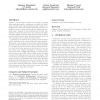Free Online Productivity Tools
i2Speak
i2Symbol
i2OCR
iTex2Img
iWeb2Print
iWeb2Shot
i2Type
iPdf2Split
iPdf2Merge
i2Bopomofo
i2Arabic
i2Style
i2Image
i2PDF
iLatex2Rtf
Sci2ools
ISSTA
2009
ACM
2009
ACM
Precise pointer reasoning for dynamic test generation
Dynamic test generation consists of executing a program while gathering symbolic constraints on inputs from predicates encountered in branch statements, and of using a constraint solver to infer new program inputs from previous constraints in order to steer next executions towards new program paths. Variants of this technique have recently been adopted in several bug detection tools, including our whitebox fuzzer SAGE, which has found dozens of new expensive security-related bugs in many Windows applications and is now routinely used in various Microsoft groups. In this paper, we discuss how to perform precise symbolic pointer reasoning in the context of dynamic test generation. We present a new memory model for representing arbitrary symbolic pointer dereferences to memory regions accessible by a program during its execution, and show that this memory model is the most precise one can hope for in our context, under some realistic assumptions. We also describe how the symbolic constra...
Dynamic Test Generation | ISSTA 2009 | Software Engineering | Symbolic Pointer | Symbolic Pointer Reasoning |
| Added | 28 May 2010 |
| Updated | 28 May 2010 |
| Type | Conference |
| Year | 2009 |
| Where | ISSTA |
| Authors | Bassem Elkarablieh, Patrice Godefroid, Michael Y. Levin |
Comments (0)

